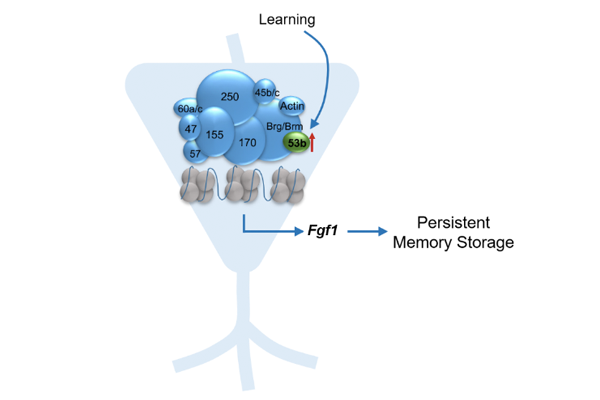How our brains store learned information persistently has long been one of the most interesting and fundamental questions in neuroscience research. In particular, there have been strong efforts to understand the molecular nature of memory storage, not only because it defines who we are but also because it is essential to develop treatments for memory-related disorders such as post-traumatic stress disorder (PTSD) and Alzheimer’s disease. However, how molecules in the nerve cells that undergo time-dependent degradation support a persistent storage of memory still remains a mystery. Using mice as a model system, a recent study conducted by a research team led by Prof. Jin-Hee Han in collaboration with Prof. InKyung Jung’s laboratory in the Department of Biological Sciences at KAIST revealed a novel molecular mechanism that contributes to make memory persist for a long time beyond 24 hours after learning. The research discovers that an epigenetic factor called BAF53b, a neuron-specific subunit of nucleosome remodeling BAF complex, induces even very late (at least up to 2 days) after learning and has a pivotal role for persistent memory storage via regulating fibroblast growth factor 1 (Fgf1) gene expression. This novel discovery has been published online in The Journal of Neuroscience.
In a prior study, Prof. Han’s group reported that BAF53b expression is regulated by learning and that such regulation is crucial for memory consolidation (BAF53b, a neuron-specific nucleosome remodeling factor, is induced after learning and facilitates long-term memory consolidation. J. Neurosci. 37: 3689-3697 (2017)). In this previous study, the researchers observed one interesting phenomenon: that the elevated level of BAF53b messenger RNA did not return to basal level even after consolidation period. This unexpected observation led the team to hypothesize that BAF53b may play an important role not only for the initial memory formation but also for its persistent storage in the brain.
In the current study, using RT-PCR and Western Blot analysis, the researchers confirmed the previous finding of delayed-induction of BAF53b by learning. The level of BAF53b protein was significantly increased in the lateral amygdala (LA) of mice even 2 days after auditory fear conditioning. To explore the role of the delayed induction, they employed RNAi method to transiently and temporally specifically knockdown BAF53b by injecting BAF53b siRNA into the LA 24 hours after learning. They tested memory in mice injected with the siRNA 6 d (remote) or 1 d (recent) after the siRNA injection and found that remote memory was specifically impaired while recent memory was normal. This indicates that late-induced BAF53b by learning is essential specifically for the remote but not recent memory formation.
Because BAF53b is the epigenetic factor involved in gene expression regulation via chromatin remodeling mechanism, the research team searched for a potential down effector molecule mediating the BAF53b function using RNA-sequencing analysis in collaboration with Prof. InKyung Jung’s laboratory. From the collaborative efforts, they identified several candidate genes whose up- or down-regulation by learning was affected by BAF53b knockdown. Among those genes, FGF1 was the one whose expression was upregulated by learning and known to be involved in regulation of memory strength. Therefore, they chose FGF1 for further testing. Remarkably, they found that FGF1 peptide injection rescues the impairment of memory persistence by BAF53b knockdown, suggesting that BAF53b regulates memory persistence via FGF1.
In summary, it is still unclear how once-consolidated memory persists over time. This study reports a delayed induction of an epigenetic factor BAF53b and fibroblast growth factor1 (FGF1) in the amygdala after fear learning and its crucial role for persistence of established memory beyond 24 hours after learning. Findings from this study give insight into a molecular mechanism of fear memory persistence and provide a potential molecular target to treat mental disorders caused by enduring traumatic memory.
This work was supported by the National Research Foundation of Korea (2018R1A2B3004486).

Miran Yoo, Prof. Jin-Hee Han Dept. of Biological Sciences, KAIST
Homepage: https://sites.google.com/site/neuralcircuitandbehaviorlab/
E-mail: han.jinhee@kaist.ac.kr






